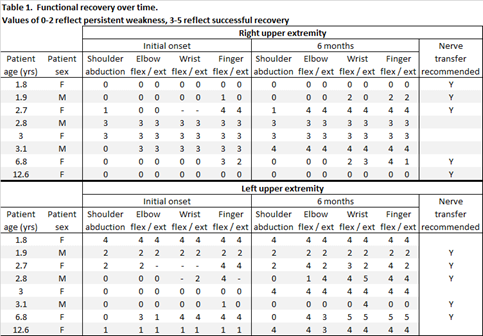Predictors of severity and recovery in virus-mediated acute flaccid myelitis
Erin L Weber, MD, PhD; Division of Plastic and Reconstructive Surgery, University of Southern California, Los Angeles, CA; Mitchel Seruya, MD; University of Southern California, Los Angeles, CA; Children's Hospital Los Angeles, Los Angeles, CA
Background: Acute flaccid myelitis (AFM) is the sudden onset of limb paralysis following a viral illness. With eradication of the poliovirus, cases of AFM are extremely rare. However, clustered outbreaks of AFM in the United States and throughout the developed world are increasing, raising concern that another polio-like epidemic could be imminent. The purpose of this study was to identify predictors of disease severity and upper limb recovery in our regional population.
Methods: A retrospective chart review was performed to identify all cases of viral-related acute flaccid myelitis treated at our pediatric institution between 2014 and 2017. Patient age, sex, prodromal symptoms, time from viral illness to onset of paralysis, past medical history, and medical therapy (steroids, intravenous immunoglobulins, and fluoxetine) were reviewed. Functional deficits and improvements over time were assessed using the Medical Research Council (MRC) scale for muscle strength. Successful recovery for each muscle group was defined as ?M3 function.
Results: Eight patients qualified for inclusion, with an age range of 2-13 years and an equal gender distribution. 75% had bilateral upper extremity paralysis. There was no correlation between disease severity and age, sex, prodromal symptoms, or time to onset of paralysis. In cases of bilateral paralysis, the degree and pattern of functional loss was not similar between limbs. All patients were managed with steroid, intravenous immunoglobulins, and/or fluoxetine therapy. Varied degrees of recovery were observed in 63% by the 6-month mark, with no correlation with the type of medical therapy (Table 1). Proximal upper extremity function, particularly shoulder abduction, was more frequently affected and less likely to recover. The frequency of successful functional recovery was not related to the severity of initial paralysis. Interestingly, a history of asthma was common to those patients who showed no signs of recovery. Ultimately, nerve transfer procedures were recommended in 88% of patients to maximize function.
Conclusions: In acute flaccid myelitis, there are few clear predictors of disease severity, progression, and recovery. However, a history of asthma may predict more severe paralysis and decreased spontaneous recovery. If functional recovery is not evident by 6 months, long-term improvement is unlikely and surgical intervention is prudent. Nerve transfer should prioritize the shoulder and elbow, as these functions are most frequently and most severely affected.
Back to 2018 Program
